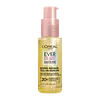L'Oreal Ever Pure Bond Repair Oil-In-Serum Versus L'Oreal Elvive Extraordinary Oil Miracle Hair Perfector
What's inside
What's inside
 Key Ingredients
Key Ingredients

 Benefits
Benefits

 Concerns
Concerns

 Ingredients Side-by-side
Ingredients Side-by-side

Isododecane
EmollientDipropylene Glycol
HumectantWater
Skin ConditioningDimethicone
EmollientAlcohol Denat.
AntimicrobialGlycerin
HumectantDimethiconol
EmollientPEG-14 Dimethicone
Skin ConditioningHydroxyethyl Urea
HumectantParfum
MaskingCitric Acid
BufferingPhenoxyethanol
PreservativePolyacrylamide
PEG-60 Hydrogenated Castor Oil
EmulsifyingC13-14 Isoparaffin
EmollientSodium Citrate
BufferingLaureth-7
EmulsifyingPropylene Glycol
HumectantLinalool
PerfumingLimonene
PerfumingHydroxycitronellal
PerfumingCitronellol
PerfumingIsoeugenol
PerfumingCitral
PerfumingPentaerythrityl Tetra-Di-T-Butyl Hydroxyhydrocinnamate
AntioxidantIsododecane, Dipropylene Glycol, Water, Dimethicone, Alcohol Denat., Glycerin, Dimethiconol, PEG-14 Dimethicone, Hydroxyethyl Urea, Parfum, Citric Acid, Phenoxyethanol, Polyacrylamide, PEG-60 Hydrogenated Castor Oil, C13-14 Isoparaffin, Sodium Citrate, Laureth-7, Propylene Glycol, Linalool, Limonene, Hydroxycitronellal, Citronellol, Isoeugenol, Citral, Pentaerythrityl Tetra-Di-T-Butyl Hydroxyhydrocinnamate
Cyclopentasiloxane
EmollientDimethiconol
EmollientChamomilla Recutita Flower Extract
MaskingCocos Nucifera Oil
MaskingTocopherol
AntioxidantHelianthus Annuus Seed Oil
EmollientCalendula Officinalis Flower Extract
MaskingBenzyl Alcohol
PerfumingCinnamal
PerfumingLinalool
PerfumingLinum Usitatissimum Flower Extract
Skin ConditioningCaprylic/Capric Glycerides
EmollientCaprylic/Capric Triglyceride
MaskingGardenia Taitensis Flower
Skin ConditioningBisabolol
MaskingRosa Canina Flower Extract
AstringentBHT
AntioxidantGlycine Soja Oil
EmollientParfum
MaskingCyclopentasiloxane, Dimethiconol, Chamomilla Recutita Flower Extract, Cocos Nucifera Oil, Tocopherol, Helianthus Annuus Seed Oil, Calendula Officinalis Flower Extract, Benzyl Alcohol, Cinnamal, Linalool, Linum Usitatissimum Flower Extract, Caprylic/Capric Glycerides, Caprylic/Capric Triglyceride, Gardenia Taitensis Flower, Bisabolol, Rosa Canina Flower Extract, BHT, Glycine Soja Oil, Parfum
Ingredients Explained
These ingredients are found in both products.
Ingredients higher up in an ingredient list are typically present in a larger amount.
Dimethiconol is a silicone that resembles the popular dimethicone. Like other silicones, it is an emollient. Emollients create a thin film on skin to prevent moisture from escaping.
This ingredient helps to create a silky texture and improve spreadability. Due to its high molecular weight and thickness, it is often combined with cyclopentasiloxane.
Linalool is a fragrance and helps add scent to products. It's derived from common plants such as cinnamon, mint, citrus, and lavender.
Like Limonene, this ingredient oxidizes when exposed to air. Oxidized linalool can cause allergies and skin sensitivity.
This ingredient has a scent that is floral, spicy tropical, and citrus-like.
Learn more about LinaloolParfum is a catch-all term for an ingredient or more that is used to give a scent to products.
Also called "fragrance", this ingredient can be a blend of hundreds of chemicals or plant oils. This means every product with "fragrance" or "parfum" in the ingredients list is a different mixture.
For instance, Habanolide is a proprietary trade name for a specific aroma chemical. When used as a fragrance ingredient in cosmetics, most aroma chemicals fall under the broad labeling category of “FRAGRANCE” or “PARFUM” according to EU and US regulations.
The term 'parfum' or 'fragrance' is not regulated in many countries. In many cases, it is up to the brand to define this term.
For instance, many brands choose to label themselves as "fragrance-free" because they are not using synthetic fragrances. However, their products may still contain ingredients such as essential oils that are considered a fragrance by INCI standards.
One example is Calendula flower extract. Calendula is an essential oil that still imparts a scent or 'fragrance'.
Depending on the blend, the ingredients in the mixture can cause allergies and sensitivities on the skin. Some ingredients that are known EU allergens include linalool and citronellol.
Parfum can also be used to mask or cover an unpleasant scent.
The bottom line is: not all fragrances/parfum/ingredients are created equally. If you are worried about fragrances, we recommend taking a closer look at an ingredient. And of course, we always recommend speaking with a professional.
Learn more about Parfum